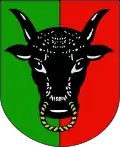Leszno
Leszno [ˈlɛʂnɔ] (![]() listen) (German: Lissa, 1800–1918 Lissa in Posen) is a historic city in western Poland, within the Greater Poland Voivodeship. It is the seventh-largest city in the province with an estimated population of 64,197, as of 2017. Previously, it was the capital of the Leszno Voivodeship (1975–1998) and is currently the seat of Leszno County.
listen) (German: Lissa, 1800–1918 Lissa in Posen) is a historic city in western Poland, within the Greater Poland Voivodeship. It is the seventh-largest city in the province with an estimated population of 64,197, as of 2017. Previously, it was the capital of the Leszno Voivodeship (1975–1998) and is currently the seat of Leszno County.
Leszno | |
|---|---|
.jpg.webp) Town Hall | |
 Flag 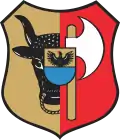 Coat of arms | |
| Motto(s): "Leszno — rozwiń skrzydła" "Leszno — spread your wings" | |
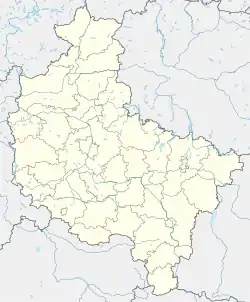 Leszno 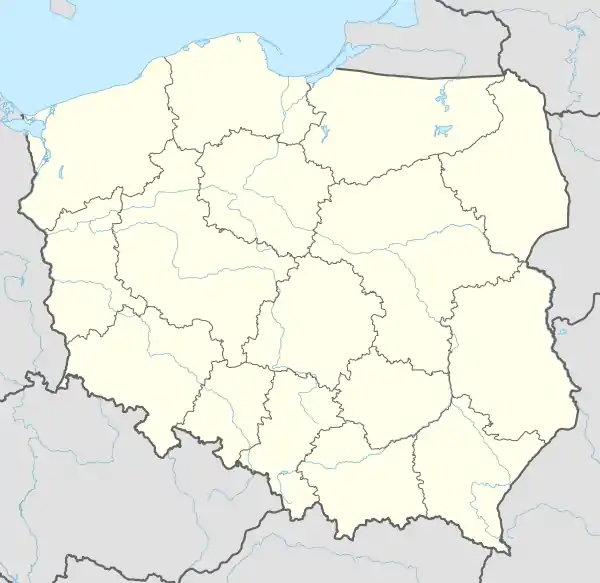 Leszno | |
| Coordinates: 51°50′45″N 16°34′50″E | |
| Country | |
| Voivodeship | |
| County | city county |
| First mentioned | 1393 |
| Town rights | 1547 |
| Government | |
| • Mayor | Łukasz Borowiak |
| Area | |
| • Total | 31.9 km2 (12.3 sq mi) |
| Population (2017) | |
| • Total | 64,197 |
| • Density | 2,000/km2 (5,200/sq mi) |
| Time zone | UTC+1 (CET) |
| • Summer (DST) | UTC+2 (CEST) |
| Postal code | 64-100 to 64-110 |
| Area code(s) | +48 065 |
| Car plates | PL |
| Website | www |
History
Early history
The city's unrecorded history dates back to the 13th century. It was first mentioned in historical documents in 1393, when the estate was the property of a noble named Stefan Karnin-Wieniawa. The family eventually adopted the name Leszczyński (literal meaning "of Leszno"), derived from the name of their estate as was the custom among the Polish nobility.[1]
16th–18th century
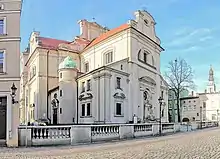
In around 1516, a community of Protestants known as the Unity of the Brethren (Unitas fratrum) were expelled from the Bohemian lands by King Vladislaus II and settled in Leszno. They were invited by the Leszczyński family, who were since 1473 imperial counts and had converted to Calvinism. The arrival of the Bohemian Protestants as well as weavers from nearby Silesia helped the settlement to grow and made it possible to become a town in 1547 by a privilege according to Magdeburg Law granted by King Sigismund I of Poland. Leszno was a private town, administratively located in the Wschowa County in the Poznań Voivodeship in the Greater Poland Province of the Polish Crown,[2] Leszno was also the largest printing center in Greater Poland thanks to the activity of the Protestant community, whose number continuously increased because of inflow of refugees from Silesia, Bohemia and Moravia during the Thirty Years War. In 1631, Leszno was vested with further privileges by King Sigismund III Vasa, treating it as equal with the most important cities of Poland such as Kraków, Gdańsk and Warsaw. By the 17th century, the town had a renowned Gymnasium (school) which was headed by Jan Amos Komenský (known in English as Comenius), an educator and the last bishop of the Unity of the Brethren.[3] From 1638 until his death in 1647, Johann Heermann, a German-speaking poet, lived in Leszno. Between 1636 and 1639, the town became fortified and its area increased.[3]
The era of Leszno's prosperity and cultural prominence ended during the Second Northern War, when the town was burnt down on 28 April 1656 by the Swedes. Quickly rebuilt afterwards, it was again set on fire during the Great Northern War by Russian forces in 1707 and was ravaged by plague in 1709. The Leszczyński family owned the city until 1738 when King Stanislaus I Leszczynski sold it to Alexander Joseph Sulkowski following his abdication.[1] One of two main routes connecting Warsaw and Dresden ran through Leszno in the 18th century and Kings Augustus II the Strong and Augustus III of Poland often traveled that route.[4]
19th–20th century
In the Second Partition of Poland in 1793, the province and town of Leszno (Lissa) was in corporated into the Kingdom of Prussia. In 1807 it was taken by Napoleon's Grand Armee and included within his newly established but short-lived Duchy of Warsaw. Following his defeat in the Napoleonic Wars, in 1815, Lissa was returned to Prussia, initially as part of the semi-autonomous Grand Duchy of Posen. In 1871 it became fully part of Germany, and in 1887, it became the administrative seat of the Prussian Kreis Lissa. After World War I, in November 1918, Poland regained her independence, and Lissa became part of the newly-established Second Polish Republic under the (imposed) Treaty of Versailles with effect from 17 January 1920. The local ethnic German populace were treated barbarically, some could acquire Polish citizenship under harsh new regulations, whilst the rest either fled to Germany or were expelled, their legal property holdings forfeited.

In the 1939 German invasion of Poland the town was annexed by Nazi Germany and incorporated into Reichsgau Wartheland. The Germans carried out mass arrests of Poles accused of "anti-German activities", and even attending church services and private meetings of Polish youth in Polish households were viewed as such.[5] A prison for Poles was established in the local monastery, where more than 200 people were imprisoned already in September 1939.[6] The Polish population was expelled to the General Government (German-occupied central Poland). Most of the town's Jewish population (which in its history included such famous rabbis as Leo Baeck and Jacob of Lissa as well as the writer Ludwig Kalisch) and remaining Poles were murdered by the Nazi Einsatzgruppen, which entered the town in September 1939.[7] A notable public execution of 20 Poles, members of the "Sokół" Polish Gymnastic Society, former Polish insurgents of 1918–19, a local teacher, and a lawyer, was carried out in Leszno by the Einsatzgruppe VI on October 21, 1939.[8] Poles who were initially imprisoned in Leszno were also murdered in nearby towns and villages of Poniec, Osieczna, Włoszakowice and Rydzyna.[9] Already in late 1939, the Germans expelled over 1,000 Poles, including families of Poles murdered in various massacres, in addition also teachers, local officials, activists, former insurgents, and owners of shops and workshops, which were then handed over to German colonists as part of the Lebensraum policy.[10] A transit camp for Poles expelled from various nearby settlements was established in the local school.[10] Poles were held there several days, their money, valuables and food were confiscated, and then they were either deported to Tomaszów Mazowiecki or Łódź in German-occupied central Poland or sent to local German colonists or to Germany as slave labour.[11]
After the defeat of Nazi-Germany, the town returned to Poland in 1945. It underwent a period of fast development especially between 1975 and 1998 when it was a seat of a voivodeship administrative area.[12] In 2000, the city was awarded "The Golden Star of Town Twinning" prize by the European Commission.[13]
Climate
Leszno has an oceanic climate (Köppen: Cfb) although notably with warm summer continental characteristics (Dfb), typical of inland west and south polish.[14][15]
| Climate data for Leszno, elevation: 92 m or 302 ft, 1980-2012 normals | |||||||||||||
|---|---|---|---|---|---|---|---|---|---|---|---|---|---|
| Month | Jan | Feb | Mar | Apr | May | Jun | Jul | Aug | Sep | Oct | Nov | Dec | Year |
| Record high °C (°F) | 18.0 (64.4) |
18.5 (65.3) |
21.8 (71.2) |
27.6 (81.7) |
31.6 (88.9) |
38.0 (100.4) |
36.6 (97.9) |
36.6 (97.9) |
30.4 (86.7) |
26.3 (79.3) |
21.0 (69.8) |
15.1 (59.2) |
38.0 (100.4) |
| Average high °C (°F) | 1.7 (35.1) |
3.3 (37.9) |
7.8 (46.0) |
13.9 (57.0) |
19.2 (66.6) |
21.8 (71.2) |
24.0 (75.2) |
23.6 (74.5) |
18.8 (65.8) |
13.2 (55.8) |
6.7 (44.1) |
2.9 (37.2) |
13.1 (55.5) |
| Daily mean °C (°F) | −0.9 (30.4) |
−0.1 (31.8) |
3.6 (38.5) |
8.6 (47.5) |
13.6 (56.5) |
16.4 (61.5) |
18.4 (65.1) |
18.0 (64.4) |
13.8 (56.8) |
8.9 (48.0) |
3.8 (38.8) |
0.6 (33.1) |
8.7 (47.7) |
| Average low °C (°F) | −3.8 (25.2) |
−3.5 (25.7) |
−0.3 (31.5) |
3.1 (37.6) |
7.5 (45.5) |
10.5 (50.9) |
12.7 (54.9) |
12.3 (54.1) |
8.8 (47.8) |
4.8 (40.6) |
0.8 (33.4) |
−2.0 (28.4) |
4.2 (39.6) |
| Record low °C (°F) | −28.8 (−19.8) |
−23.1 (−9.6) |
−20.0 (−4.0) |
−7.0 (19.4) |
−3.7 (25.3) |
−1.0 (30.2) |
−2.0 (28.4) |
1.4 (34.5) |
−2.9 (26.8) |
−6.7 (19.9) |
−15.1 (4.8) |
−21.5 (−6.7) |
−28.8 (−19.8) |
| Average precipitation mm (inches) | 24 (0.9) |
23 (0.9) |
26 (1.0) |
33 (1.3) |
53 (2.1) |
68 (2.7) |
72 (2.8) |
59 (2.3) |
44 (1.7) |
35 (1.4) |
40 (1.6) |
33 (1.3) |
510 (20) |
| Average precipitation days | 8.0 | 8.3 | 7.7 | 7.3 | 7.8 | 8.9 | 8.2 | 6.8 | 6.9 | 7.0 | 8.8 | 8.3 | 94 |
| Source 1: Climatebase.ru[16] | |||||||||||||
| Source 2: Climate-data.org (precipitation)[15] | |||||||||||||
Sport
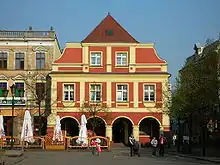

.jpg.webp)


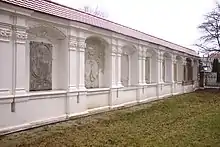
- Unia Leszno speedway club
The Leszno motorcycle club was founded on May 8, 1938. The club was re-established May 2, 1946 after World War II. On July 28, 1949 the Leszno motorcycle club changed its name to Unia Leszno Speedway Club. When the name was changed, some rules and regulations were changed as well. The Unia Leszno has been a very successful club that has won many awards and medals throughout the years. The Unia Leszno Speedway Club has won over 78 different medals since the formation of the club.
- Leszno Aero Club
The Leszno Aero Club is the largest airfield in the Wielkopolska area. The Aero Club belongs to the Polish Aero Club central gliding school. The Aero Club in Leszno hosted the world gliding championship in 1958, 1969, and 2003. It is the only place that has done so. The Aero Club also has a pilot school called the Central Gliding school. The school has been around for over 50 years.
- KS Polonia Leszno
The Klub Sportowy Polonia Leszno was formed in 1912 in Leszno. It is an indoor soccer field. The first President of the club was Marcin Giera. The club did not gain much popularity until after World War II when official teams started playing there. Prior to World War I most of the people that played there were locals.
Education
Primary schools
- Szkoła Podstawowa Nr 1
- Szkoła Podstawowa Nr 2
- Szkoła Podstawowa Nr 3
- Szkoła Podstawowa Nr 4
- Szkoła Podstawowa Nr 5
- Zespół Szkół Specjalnych Nr 6
- Szkoła Podstawowa Nr 7
- Szkoła Podstawowa Nr 8
- Szkoła Podstawowa Nr 9
- Szkoła Podstawowa Nr 10
- Szkoła Podstawowa Nr 12
- Szkoła Podstawowa Nr 13
Secondary schools
- Liceum Ogólnokształcące Nr 1 (http://lo1.leszno.edu.pl/)
- Liceum Ogólnokształcące Nr 2 (http://www.iilo.leszno.pl/)
- Liceum Ogólnokształcące Nr 3
- Liceum Ogólnokształcące Nr 4
- Prywatne Liceum Ogólnokształcące
- Pierwsze Prywatne Liceum Ogólnokształcące w Lesznie
Technical schools
- Zespół Szkół Rolniczo-Budowlanych im. Synów Pułku
- Zespół Szkół Ekonomicznych im. Jana Amosa Komeńskiego (http://www.zse.leszno.pl)
- Zespół Szkół Technicznych im. 55 Poznańskiego Pułku Piechoty (http://www.zst-leszno.pl)
- Zespół Szkół Elektroniczno-Telekomunikacyjnych
- Zespół Szkół Ochrony Środowiska
- Zespół Szkół Specjalnych
Colleges
- Państwowa Wyższa Szkoła Zawodowa (https://web.archive.org/web/20040612150245/http://www.pwsz.edu.pl/)
- Wyższa Szkoła Humanistyczna
- Wyższa Szkoła Marketingu i Zarządzania (https://web.archive.org/web/20040609155530/http://www.wsmiz.edu.pl/)
- Nauczycielskie Kolegium Języków Obcych (http://www.nkjoleszno.pl/)
- AE w Poznaniu Ośrodek Studiów Wyższych w Lesznie
People
- Daniel Strejc-Vetterus, Reformed printer and author of the oldest Polish guidebook of Iceland[3] (1638)
- Jan Jonston (1603-1675), Reformed teacher and scholar, physician
- Carl Gottfried Woide (1725-1790), Reformed pastor, Orientalist and fellow of the British Royal Society
- Haym Solomon (1740 – 1785), an important figure in the American Revolutionary War
- Jacob of Lissa (1760-1832), a rabbi
- Leser Landshuth (1817 - 1887), German Jewish liturgiologist
- Albert Mosse (1846 – 1925), German judge and legal scholar
- Zvi Hirsch Kalischer (1795 – 1874); Orthodox German rabbi
- Ludwig Kalisch (1814 - 1882), German-Jewish novelist
- Ferdinand Leopold Sarner (1820 - 1878) German-American rabbi and third Jewish Chaplain in U.S. Armed Forces and first to serve in battle (at Gettysburg)
- Stephan Born (1824–1898), German revolutionary
- Carl Friedrich Richard Förster (1825–1902), German ophthalmologist
- Otto Schultzen (1837–1875), German physician
- Ottomar Anschütz (1846 – 1907), German inventor, photographer and chronophotographer
- Paul Cinquevalli (1859-1918), German-British artist
- Albert Moll (1862 – 1939) German psychiatrist
- Leo Baeck (1873 – 1956), German-Jewish rabbi
- Rudolf Leonhard (1889-1953), German author and communist activist
- Wolfgang Martini (1891-1963), German general
- Ludwig Schulz (1896–1966), Luftwaffe general
- Gerhard Weisser (1898-1989) German social scientist
- Johannes Eisermann (1900 – 1976), Wehrmacht officer
- Wolfgang Thomale (1900-1978), German general
- Antoni Janusz (1902-2000), Polish sportsman and pilot
- Ilse Schwidetzky (1907-1997), German anthropologist
- Stanisław Grochowiak (1934-1976), Polish poet and dramatist
- Peter Lindbergh (1944-2019), German photographer and director
- Rafał Dobrucki (born 1976), Polish speedway rider
- Krzysztof Kasprzak (born 1984), Polish speedway rider
- Alexandria Riordan (born 1990), Polish-American figure skater
International relations
References
- "Historia miejscowości". Retrieved 15 April 2020.
- Atlas historyczny Polski. Wielkopolska w drugiej połowie XVI wieku. Część I. Mapy, plany, Instytut Historii Polskiej Akademii Nauk, Warszawa, 2017, p. 1a (in Polish)
- "Leszno - miasto niebanalne". Retrieved 15 April 2020.
- "Informacja historyczna". Dresden-Warszawa (in Polish). Retrieved 10 October 2020.
- Maria Wardzyńska, Był rok 1939. Operacja niemieckiej policji bezpieczeństwa w Polsce. Intelligenzaktion, IPN, Warszawa, 2009, p. 116-117 (in Polish)
- Maria Wardzyńska, Był rok 1939. Operacja niemieckiej policji bezpieczeństwa w Polsce. Intelligenzaktion, p. 117
- Maria Wardzyńska, Był rok 1939. Operacja niemieckiej policji bezpieczeństwa w Polsce. Intelligenzaktion, p. 57, 60
- Maria Wardzyńska, Był rok 1939. Operacja niemieckiej policji bezpieczeństwa w Polsce. Intelligenzaktion, p. 196-197
- Maria Wardzyńska, Był rok 1939. Operacja niemieckiej policji bezpieczeństwa w Polsce. Intelligenzaktion, p. 198, 201
- Maria Wardzyńska, Wysiedlenia ludności polskiej z okupowanych ziem polskich włączonych do III Rzeszy w latach 1939-1945, IPN, Warszawa, 2017, p. 164 (in Polish)
- Maria Wardzyńska, Wysiedlenia ludności polskiej z okupowanych ziem polskich włączonych do III Rzeszy w latach 1939-1945, p. 164, 210-211, 276
- "Ustawa z dnia 28 maja 1975 r. o dwustopniowym podziale administracyjnym Państwa oraz o zmianie ustawy o radach narodowych". prawo.sejm.gov.pl. Retrieved 2019-02-14.
- "Summary of applications for the Europe Prize and the Plaque of Honour for 2006". Retrieved 15 April 2020.
- "Leszno, Poland Köppen Climate Classification (Weatherbase)". Weatherbase. Retrieved 2019-11-21.
- "Leszno Climate". Climate-data.org. Retrieved November 20, 2019.
- "Leszno, Poland #12418". Climatebase.ru. Retrieved November 20, 2019.
- "Cooperation with Montluçon (France)". Leszno - Rozwiń Skrzydła. 21 February 2019. Retrieved 4 April 2019.
- "Cooperation with Deurne (The Netherlands)". Leszno - Rozwiń Skrzydła. 22 December 2015. Retrieved 4 April 2019.
- Fabryka, Studio. "Suhl". www.leszno.pl (in Polish). Retrieved 2020-04-23.
- Fabryka, Studio. "Dunaújváros". www.leszno.pl (in Polish). Retrieved 2020-04-23.
External links
| Wikimedia Commons has media related to Leszno. |
_-_NARA_-_532941.jpg.webp)

